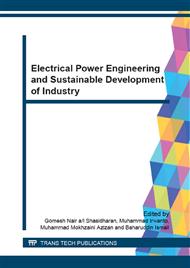[1]
R. Foster, M. Ghassem, A. Cota: Solar energy renewable energy and the environment. CRC Press, Taylor & Francis Group. 6000 Broken Sound Parkway NW, Suite 300, Boca Raton, FL 33487-2742, (2010).
DOI: 10.2135/cropsci2007.10.0003br
Google Scholar
[2]
H. Wanga, J. Wanga, J. Yaoa, W. Yuanb, L. Caoa: Analysis on the Aerodynamic Performance of Vertical Axis Wind Turbine Subjected to the Change of Wind Velocity. Procedia Engineering. Vol. 31, 2012, p.213 – 219.
DOI: 10.1016/j.proeng.2012.01.1014
Google Scholar
[3]
A. C. Aranake, V. K. Lakshminarayan, K. Duraisamy: Computational Analysis of Shrouded Wind Turbine Configurations. 51st AIAA Aerospace Sciences Meeting including the New Horizons Forum and Aerospace Exposition, Grapevine (Dallas/Ft Worth Region), Texas, 1-17, (2013).
DOI: 10.2514/6.2013-1211
Google Scholar
[4]
K. Kacprzak, G. Liskiewicz and K. Sobczak: Numerical Investigation of Conventional and Modified Savonius Wind Turbines, " Renewable energy, Vol. 60, 2013, PP. 578-585.
DOI: 10.1016/j.renene.2013.06.009
Google Scholar
[5]
M. Mohamed, G. Janiga, E. Pap, D. Thevenin: Optimal Blade Shape of a Modified Savonius Turbine Using an Obstacle Shielding the Returning Blade, Energy Conversion and Management, Vol. 52, 2011, PP. 230-242.
DOI: 10.1016/j.enconman.2010.06.070
Google Scholar
[6]
A. Dragomirescu: Performance assessment of a small wind turbine with cross flow runner by numerical simulations, Renewable, Vol. 36, 2011, PP. 957-65.
DOI: 10.1016/j.renene.2010.07.028
Google Scholar
[7]
S. McTavish, D. Feszty, T. Sankar, Steady and rotating computational fluid dynamics simulations of a novel vertical axis wind turbine for small-scale power generation,. Renewable Energy, vol. 4, 2012, PP. 171-179.
DOI: 10.1016/j.renene.2011.10.018
Google Scholar
[8]
M. Nini, V. Matta, G. Bindolino, A. Guardone, Three-dimensional simulation of a complete vertical axis wind turbine using overlapping grids, Computational and Applied Mechanics, In Press, (2014).
DOI: 10.1016/j.cam.2014.02.020
Google Scholar
[9]
N. Fuller, D. M. Wienes, A. Johnston, J. French: Design and analysis of the aerodynamic components for a kilowatt scale VAWT optimized for low altitude implementation in remote rural villages, ASME 2011 5th International Conference on Energy Sustainability ES2011. August 7-10, Washington, DC, USA, (2011).
DOI: 10.1115/es2011-54550
Google Scholar
[10]
S. Roy, U. K. Saha: Review on the numerical investigations into the design and development of Savonius wind rotors, Renewable and Sustainable Energy Reviews, Vol. 24, 2013, p.73 – 83.
DOI: 10.1016/j.rser.2013.03.060
Google Scholar


